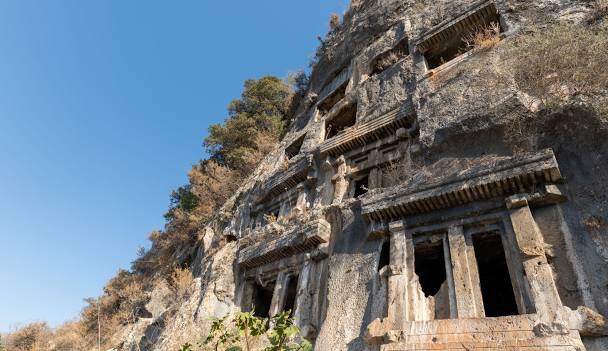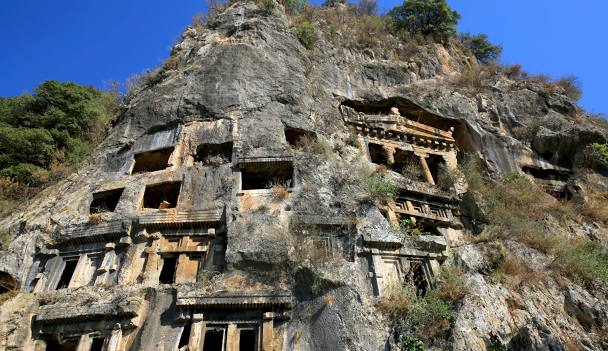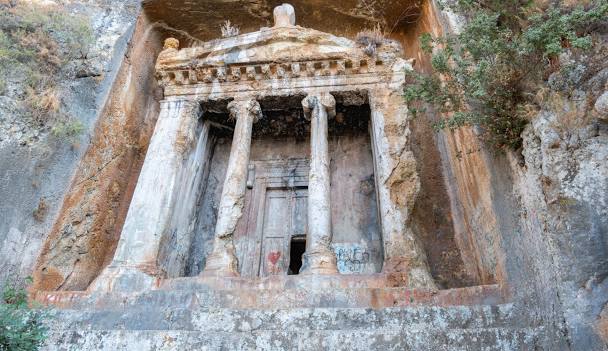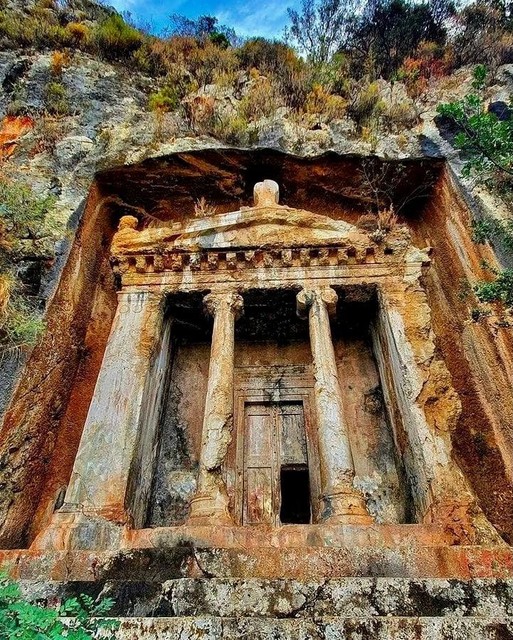The Tomb of Amyntas is a remarkable ancient Greek rock-hewn tomb located in the ancient city of Telmessos, Lycia, modern-day Fethiye, Turkey. Constructed in 350 BC, this historical site continues to captivate visitors with its architectural grandeur and cultural significance. Named after the Greek inscription on its side, which reads, “Amyntas son of Hermagios,” the tomb stands as a testament to the rich history of the Lycian region. Follow archeology.dulichvn.net to learn more about mysterious artifacts.

1. Historical Background of the Tomb of Amyntas
1.1 The Era of Construction
The Tomb of Amyntas was constructed around 350 BC, a time when Lycia was deeply influenced by the cultural and artistic advancements of ancient Greece. This era, often referred to as a pinnacle of classical antiquity, saw a unique fusion of Lycian and Greek styles, especially in monumental architecture. The tomb’s intricate carvings and imposing structure reflect this blend, illustrating how the Lycians embraced Greek aesthetics while retaining their cultural identity. This synthesis is evident in the tomb’s detailed façade, which mirrors the grandeur of Greek temples yet retains distinct Lycian characteristics, symbolizing the region’s dynamic cultural exchanges during this period.
1.2 The Identity of Amyntas
The tomb derives its name from the Greek inscription etched into its façade, which reads, “Amyntas son of Hermagios.” This inscription hints at the prominence of Amyntas, who was likely a figure of considerable importance in Lycian society. Scholars speculate that he may have been a nobleman, a military commander, or a person of high status within the local aristocracy. The elaborate design and scale of the tomb further support this theory, suggesting it was commissioned to honor a person of great influence. The tomb thus not only immortalizes Amyntas but also provides a glimpse into the hierarchical structure and values of ancient Lycian society.
1.3 Telmessos: The City of Legends
Nestled in the heart of ancient Lycia, Telmessos—modern-day Fethiye—was a city steeped in cultural and spiritual significance. Renowned as a hub of prophecy and divination, it was home to an oracle that rivaled those of Greece in its influence. Telmessos also played a vital role as a cultural crossroads, where Greek mythology and Lycian traditions intertwined. The Tomb of Amyntas, perched high on a rocky cliff overlooking the city, embodies the city’s legendary status. Its commanding location and architectural brilliance reflect the region’s historical prominence, further enriching the mystique surrounding Telmessos and its enduring connection to ancient myth and legend.

2. Architectural Significance of the Tomb
2.1 A Rock-Hewn Masterpiece
The Tomb of Amyntas stands as a testament to the remarkable craftsmanship of ancient Lycian stonemasons. Carved directly into the rugged cliff face, the tomb exemplifies the region’s distinctive funerary architecture, where natural landscapes were seamlessly integrated into monumental designs. This labor-intensive process required extraordinary precision and skill, as the craftsmen sculpted massive stone blocks to create an awe-inspiring structure that has endured for centuries. The towering position of the tomb not only accentuates its grandeur but also reflects the symbolic aspiration of reaching closer to the heavens, a theme often seen in Lycian burial practices.
2.2 The Elegance of Doric Column Design
The façade of the Tomb of Amyntas is a masterclass in classical design, adorned with Doric-style columns that echo the architectural traditions of ancient Greece. These columns, known for their simplicity and strength, lend the structure a sense of majesty and timeless elegance. The symmetrical layout of the tomb’s entrance, framed by these columns, conveys a sense of order and balance, emphasizing the status and importance of Amyntas, for whom the tomb was constructed. This fusion of Greek architectural elements with Lycian craftsmanship underscores the cultural exchanges that defined the region during the 4th century BC.
2.3 A Solemn Interior Layout
Beyond its ornate exterior, the interior of the Tomb of Amyntas reveals a stark contrast in design. The burial chamber, designed to house the remains of the noble Amyntas, is relatively austere, reflecting its solemn purpose. This simplicity draws attention to the tomb’s role as a sacred space for eternal rest, in contrast to the elaborate exterior, which serves as a public testament to the deceased’s prestige. The modest interior layout also highlights the ingenuity of Lycian architects, who prioritized both functionality and symbolic expression, ensuring the tomb’s enduring legacy as a cultural and historical marvel.

3. Cultural and Touristic Importance
3.1 A Window into Ancient Lycia
The Tomb of Amyntas is not merely a historical monument; it serves as a vital key to understanding the cultural and architectural practices of ancient Lycia. Its intricate design reflects the harmonious blend of Lycian traditions and Greek influences, offering scholars and historians a glimpse into the region’s artistic evolution. The tomb’s grandeur and precision also shed light on the advanced engineering techniques employed by ancient stonemasons, highlighting the sophistication of Lycian society. As one of the most iconic relics of the era, it stands as a testament to the ingenuity and cultural richness of this ancient civilization.
3.2 A Must-Visit Landmark
Perched high on the cliffs overlooking modern-day Fethiye, the Tomb of Amyntas has become a magnet for history enthusiasts and travelers alike. The trek to the tomb is as rewarding as the destination itself, with paths winding through lush landscapes, offering glimpses of the breathtaking views awaiting at the summit. Upon arrival, visitors are often struck by the tomb’s intricate details and imposing presence. Beyond its architectural beauty, the site provides panoramic vistas of Fethiye and the turquoise waters of the Mediterranean, making it a destination that appeals to both history buffs and nature lovers.
3.3 Preservation Efforts
Recognizing its historical and cultural significance, ongoing efforts are being made to preserve the Tomb of Amyntas for future generations. Conservation projects focus on mitigating the effects of natural erosion, weathering, and human activities that threaten the tomb’s structural integrity. Local authorities and heritage organizations are also working to raise awareness about the importance of preserving this iconic landmark. Protective measures, including restricted access to certain areas and careful monitoring, ensure that the tomb remains a treasured part of Lycian heritage, allowing it to continue inspiring awe and admiration for centuries to come.
See more: Chedworth Roman Villa: Discovering the Timeless Beauty
Conclusion
The Tomb of Amyntas is not just a burial site but a profound symbol of ancient Lycian-Greek culture and architectural brilliance. Its historical significance, stunning design, and cultural legacy make it a must-visit destination for history enthusiasts and travelers alike. A journey to this site is a step back in time, offering a deeper appreciation of the remarkable achievements of ancient civilizations.


CÁC TIN KHÁC
Mary Walton: The Forgotten Inventor Who Helped Clean Up America’s Cities
Tomb of Queen Nefertari in the Valley of the Queens, Egypt
Discover the Hypostyle Hall of the Temple of Hathor at Dendera
Venus de Losange: Unveiling the Mystery of a 20,000-Year-Old Paleolithic Icon